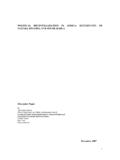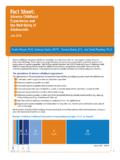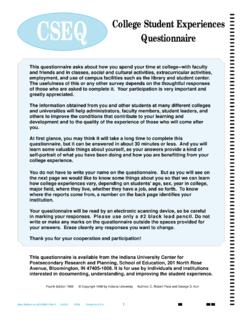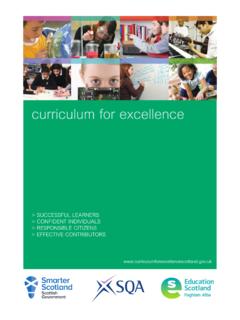Transcription of FARMER´S COMPOST HANDBOOK
1 1 FARMER S COMPOST HANDBOOK Experiences in Latin America2 FARMER S COMPOST HANDBOOK Experiences in Latin AmericaFood and Agriculture Organization of the United NationsRegional Office for Latin America and the CaribbeanSantiago, 2015 AuthorsPilar Rom nMar a M. Mart nezAlberto PantojaThe designations employed and the presentation of material in this information product do not imply the expression of any opinion whatsoever on the part of the Food and Agriculture Organization of the United Nations (FAO) concerning the legal or development status of any country, territory, city or area or of its authorities, or concerning the delimitation of its frontiers or boundaries. The mention of specific companies or products of manufacturers, whether or not these have been patented, does not imply that these have been endorsed or recommended by FAO in preference to others of a similar nature that are not views expressed in this information product are those of the author(s) and do not necessarily reflect the views or policies of 978-92-5-107844-0 (print) E-ISBN 978-92-5-107845-7 (PDF) FAO, 2015 FAO encourages the use, reproduction and dissemination of material in this information product.
2 Except where otherwise indicated, material may be copied, downloaded and printed for private study, research and teaching purposes, or for use in non-commercial products or services, provided that appropriate acknowledgement of FAO as the source and copyright holder is given and that FAO s endorsement of users views, products or services is not implied in any requests for translation and adaptation rights, and for resale and other commercial use rights should be made via or addressed to information products are available on the FAO website ( ) and can be purchased through of contents1. Role of FAO in soil preservation 12. Importance of organic matter in the soil 53. Theoretical foundations of composting 9 Composting process 10 Composting phases 11 Monitoring during composting 13 Hygienization and safety 20 Composting material 21 Fertilization 22 COMPOST application 30 Costs 314.
3 Practical foundations of composting 33 Recommended tools 34 Composting techniques 35 Open air composting 35 Tasks to be performed to build and manage a COMPOST pile 40 Experiences of COMPOST piles in latin america 47 Composting in containers 48 Tasks to be performed when composting in containers 52 Decision tree 535. COMPOST -related products 55 Vermicompost 56 COMPOST tea 606. Experiences in Latin America 65 COMPOST production from pig breeding 66 COMPOST pile in peri-urban farming 71 COMPOST piles withouth turning 72 Horizontal metal COMPOST barrel in urban farming 75 Horizontal plastic COMPOST drum in family farming 77 COMPOST production from lettuce waste 797.
4 Annex 81 Conversion factors 82 Field analysis of the need of fertilizers 82 Analysis of COMPOST safety 83 Vermicompost 85 Benefits of COMPOST tea 858. Bibliographic references 87 IVVList of figuresFigure 1 Map of risks associated to production areas 3 Figure 2 Schematic of the evolution of organic matter in the soil 6 Figure 3 Fungus indicating mesophilic phase II 12 Figure 4 Temperature, oxygen and pH during composting process 13 Figure 5 Common COMPOST systems 18 Figure 6 Dimensions of a small farmer COMPOST pile 19 Figure 7 Average composici n of plants 23 Figure 8 Preparation of the substrate 30 Figure 9 Recommended tools 34 Figure 10 COMPOST piles. Ciudad Sandino. Nicaragua. 35 Figure 11 Forced aeration system 36 Figure 12 Leaching collection system 36 Figure 13 Mechanized turning 37 Figure 14 COMPOST pile 38 Figure 15 Available composting area 39 Figure 16 Calculator of C:N ratio 42 Figure 17 Turning modalities according to the number of piles 43 Figure 18 Process control spreadsheet 44 Figure 19 Screen used in the sieving process 45 Figure 20 Alternative sieving instruments 46 Figure 21 Composting monitoring spreadsheet 46 Figure 22 COMPOST pile cover to avoid temperature drop and excess rain.
5 Nicaragua 47 Figure 23 Photograph and schematic of the air cushion technique 47 Figure 24 Photograph and schematic of the ventilating stack technique 48 Figure 25 Types of containers for compostings 49 Figure 26 Turning a horizontal COMPOST bin 49 Figure 27 Vertical or continuous COMPOST container 50 Figure 28 Horizontal or discontinuous COMPOST drum 51 Figure 29 California red earthworm cocoon 56 Figure 30 Earthworm life cycle 57 Figure 31 Vermicompost container in a school (Honduras) 58 Figure 32 Vermicompost container in a family orchard. Managua (Nicaragua) 58 Figure 33 Vermicompost container in peri-urban farming. Asunci n (Paraguay) 58 Figure 34 Vermicompost in family farming. Neiva (Colombia) 58 Figure 35 Vermicompost drying area 60 Figure 36 Fresh COMPOST leachate. Vegetable COMPOST . Funza, Colombia 61 IVVF igure 37 Tank to obtain COMPOST tea 62 Figure 38 Pig fattening in deep litter.
6 Monte Heliconia Farm 66 Figure 39 Preparing the litter with rice husk 67 Figure 40 Pigs rooting the litter 67 Figure 41 Litter collection and building the COMPOST pile 68 Figure 42 Periodical turning of the COMPOST pile 68 Figure 43 Watering the COMPOST pile 69 Figure 44 Packaging final product 70 Figure 45 COMPOST in bioengineering. Colombia 70 Figure 46 Cleaning the pile area 71 Figure 47 Segregated material to build the pile 72 Figure 48 Thick branches forming an air cushion 72 Figure 49 Interspersed layers of material rich in carbon and nitrogen 73 Figure 50 Schematic of pile without turningn 74 Figure 51 Horizontal metal COMPOST barrel 75 Figure 52 Preparation of the COMPOST drum with material of local farmers 77 Figure 53 Fertilization of lettuce with COMPOST 79 Figure 54 Fresh material to COMPOST 80 Figure 55 Temperatures recorded during the process 80 VIVIIList of tablesTable 1 Aeration control 14 Table 2 Optimal moisture parameters 15 Table 3 Optimal temperature parameters 16 Table 4 Optimal pH parameters 17 Table 5 Carbon/Nitrogen parameters 17 Table 6 Particle size control 18 Table 7 COMPOST parameters 19 Table 8 Temperature required to eliminate most pathogens 21
7 Table 9 Average nutrients content in COMPOST 24 Table 10 Extraction of nutrients per crop 25 Table 11 Fertilizers most commonly used 26 Table 12 Conversion among P2O5, K2O, y P, K 26 Table 13 Fertilizer cost 28 Table 14 Economic balance of a COMPOST plant 31 Table 15 C:N ratio of some materials used in composting 41 Table 16 Advantages and disadvantages of closed composting systems 51 Table 17 Environmental conditions 59 Table 18 Material to COMPOST in barrel 76 Table 19 Material of the COMPOST container 78 Table 20 Symptoms of plant deficiency 82 Table 21 Microbiological limits according to different standards 84 Table 22 Chemical properties of vermicompost 85 VIVIIList of examplesExample 1 Calculation of N, P and K 27 Example 2 Economic comparison of fertilizers 28 Example 3 Calculation of fertilization requirements of a crop 29 Example 4 Calculation of the COMPOST pile dimensions according to 37 the amount of material to COMPOST Example 5 Calculation of the COMPOST pile dimensions according to 38 final COMPOST requirements Example 6 Calculation of the COMPOST pile dimensions according to 39 the available area Example 7 Calculation of the C.
8 N ratio in the mix of various materials 42 Example 8 Calculation of the appropriate volume of the COMPOST container 52 Example 9 Choice of a composting method in family farming 53 VIIIIXC ontributorsFAOJan Van Wambeke, Land and Water Senior Officer at FAO Regional Office for Latin America & the Pantoja, Crop Production and Protection Officer at FAO Regional Office for Latin America & the Caribbean. Pilar Rom n, Associated Professional Officer of Climate Change and Environmental Sustainability at FAO Regional Office for Latin America & the Caribbean. Benjamin Kiersch, Land Tenure Officer at FAO Regional Office for Latin America & the CaribbeanMeliza Gonzalez, Consultant on Agroclimatic Risk Management, at FAO Regional Office for Latin America & the CaribbeanLoreni C rdenas, Te filo Avellaneda, Humberto Rodriguez, consultants at FAO country office in ColombiaClaudio Villasanti , Jorge Gattini, consultants at FAO country office in Paraguay OTHER INSTITUTIONSM.
9 Mercedes Mart nez, Researcher, Centro Avanzado de Tecnologias para la Agricultura CATA, Universidad Federico Santa Maria. Santiago, ChileAna Karina Carrascal, Food Microbiology Laboratory. Pontificia Universidad Javeriana. Bogot , ColombiaRodrigo Ortega Blu, Centro Avanzado de Tecnologias para la Agricultura CATA, Universidad Federico Santa Maria. Santiago, ChileDaniel Enrique Borda-Molina, Researcher, School of Sciences, Pontificia Universidad Javeriana, Bogot Juan Manuel Pardo-Garcia, Resarcher, International Centre for Tropical Agriculture, Cuervo, Horticola de Hoy, ColombiaEduardo Murillo, Karla Loaisiga INTA-FAO Mart nez Municipality of Ciudad Sandino, Managua. NicaraguaVIIIIXP refaceThis Farmer s Composting HANDBOOK is a learning guide about the production of COMPOST at household and small farmer level, prepared by the FAO Regional Office for Latin America and the Caribbean, in collaboration with the Research Group on Soil, Water, Crop and Microorganisms of Universidad T cnica Federico Santa Mar aim of this paper is to disseminate suitable technologies to develop a healthy and safe product for use as fertilizer in family orchards.
10 The manual presents the vision of FAO regarding agriculture: Sustainable Intensification of Agricultural Pro-duction, with higher production in the same land surface while conserving resources, reducing negative impact on the environment and enhancing the natural capital and the provision of ecosystem publication is divided in four thematic blocks: - Theoretical Foundations of Composting- Practical Foundations of Composting- Related COMPOST products- Experiences in Latin America and the section Theoretical Foundations of Composting details important parameters to be measured to determine the quality and safety of the finished material and out-lines the benefits of COMPOST in its different section of Practical Foundations of Composting presents practical examples that allow the reader to understand how a composting system is implemented in the section Related COMPOST Products includes the production and use of COMPOST tea and vermicompost.















![arXiv:1511.05952v4 [cs.LG] 25 Feb 2016](/cache/preview/9/e/0/8/7/8/5/c/thumb-9e08785c0efa5f8d4f15f7f8dda28993.jpg)
